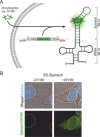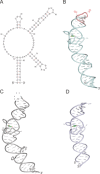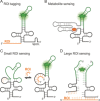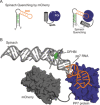RNA Structure and Cellular Applications of Fluorescent Light-Up Aptamers
- PMID: 30102012
- PMCID: PMC6391945
- DOI: 10.1002/anie.201806482
RNA Structure and Cellular Applications of Fluorescent Light-Up Aptamers
Abstract
The cellular functions of RNA are not limited to their role as blueprints for protein synthesis. In particular, noncoding RNA, such as, snRNAs, lncRNAs, miRNAs, play important roles. With increasing numbers of RNAs being identified, it is well known that the transcriptome outnumbers the proteome by far. This emphasizes the great importance of functional RNA characterization and the need to further develop tools for these investigations, many of which are still in their infancy. Fluorescent light-up aptamers (FLAPs) are RNA sequences that can bind nontoxic, cell-permeable small-molecule fluorogens and enhance their fluorescence over many orders of magnitude upon binding. FLAPs can be encoded on the DNA level using standard molecular biology tools and are subsequently transcribed into RNA by the cellular machinery, so that they can be used as fluorescent RNA tags (FLAP-tags). In this Minireview, we give a brief overview of the fluorogens that have been developed and their binding RNA aptamers, with a special focus on published crystal structures. A summary of current and future cellular FLAP applications with an emphasis on the study of RNA-RNA and RNA-protein interactions using split-FLAP and Förster resonance energy transfer (FRET) systems is given.
Keywords: RNA imaging; RNA structures; RNA-protein interactions; fluorescent light-up aptamers (FLAPs); fluorogenic probes.
© 2018 The Authors. Published by Wiley-VCH Verlag GmbH & Co. KGaA.
Conflict of interest statement
The authors declare no conflict of interest.
Figures











Similar articles
-
Structural Principles of Fluorescent RNA Aptamers.Trends Pharmacol Sci. 2017 Oct;38(10):928-939. doi: 10.1016/j.tips.2017.06.007. Epub 2017 Jul 17. Trends Pharmacol Sci. 2017. PMID: 28728963 Free PMC article. Review.
-
Recent Development of Fluorescent Light-Up RNA Aptamers.Crit Rev Anal Chem. 2022;52(7):1644-1661. doi: 10.1080/10408347.2021.1907735. Epub 2021 Apr 18. Crit Rev Anal Chem. 2022. PMID: 33870782 Review.
-
Fluorogenic aptamers resolve the flexibility of RNA junctions using orientation-dependent FRET.RNA. 2021 Apr;27(4):433-444. doi: 10.1261/rna.078220.120. Epub 2020 Dec 29. RNA. 2021. PMID: 33376189 Free PMC article.
-
Tracking RNA with light: selection, structure, and design of fluorescence turn-on RNA aptamers.Q Rev Biophys. 2019 Aug 19;52:e8. doi: 10.1017/S0033583519000064. Q Rev Biophys. 2019. PMID: 31423956 Free PMC article. Review.
-
Illuminating RNA through fluorescent light-up RNA aptamers.Biosens Bioelectron. 2025 Mar 1;271:116969. doi: 10.1016/j.bios.2024.116969. Epub 2024 Nov 27. Biosens Bioelectron. 2025. PMID: 39615220 Review.
Cited by
-
Fast-exchanging spirocyclic rhodamine probes for aptamer-based super-resolution RNA imaging.Nat Commun. 2023 Jun 30;14(1):3879. doi: 10.1038/s41467-023-39611-1. Nat Commun. 2023. PMID: 37391423 Free PMC article.
-
High-throughput, fluorescent-aptamer-based measurements of steady-state transcription rates for Mycobacterium tuberculosis RNA polymerase.bioRxiv [Preprint]. 2023 Mar 13:2023.03.13.532464. doi: 10.1101/2023.03.13.532464. bioRxiv. 2023. Update in: Nucleic Acids Res. 2023 Oct 27;51(19):e99. doi: 10.1093/nar/gkad761. PMID: 36993414 Free PMC article. Updated. Preprint.
-
Reporter-recruiting bifunctional aptasensor for bioluminescent analytical assays.RSC Adv. 2020 Sep 1;10(54):32393-32399. doi: 10.1039/d0ra05117a. eCollection 2020 Sep 1. RSC Adv. 2020. PMID: 35516485 Free PMC article.
-
Structure-based investigation of fluorogenic Pepper aptamer.Nat Chem Biol. 2021 Dec;17(12):1289-1295. doi: 10.1038/s41589-021-00884-6. Epub 2021 Nov 1. Nat Chem Biol. 2021. PMID: 34725509
-
Nucleic Acid-Binding Dyes as Versatile Photocatalysts for Atom-Transfer Radical Polymerization.J Am Chem Soc. 2024 May 15;146(19):13598-13606. doi: 10.1021/jacs.4c03513. Epub 2024 May 1. J Am Chem Soc. 2024. PMID: 38691811 Free PMC article.
References
-
- König J., Zarnack K., Luscombe N. M., Ule J., Nat. Rev. Genet. 2012, 13, 77–83. - PubMed
-
- Mercer T. R., Dinger M. E., Mattick J. S., Nat. Rev. Genet. 2009, 10, 155–159. - PubMed
-
- McHugh C. A., Russell P., Guttman M., Chen M., Manley J., Licatalosi D., Darnell R., Wang Z., Gerstein M., Snyder M., et al., Genome Biol. 2014, 15, 1–10. - PubMed
Publication types
MeSH terms
Substances
LinkOut - more resources
Full Text Sources
Other Literature Sources

